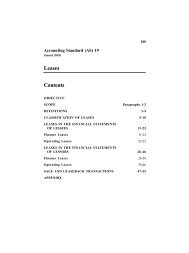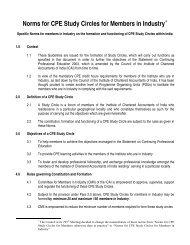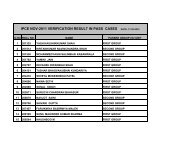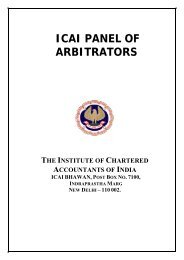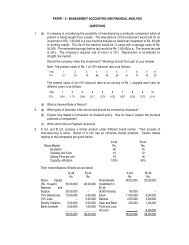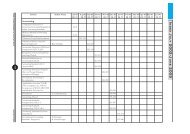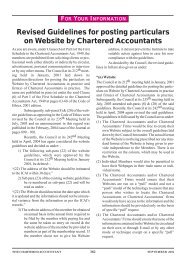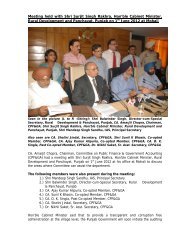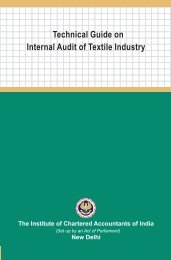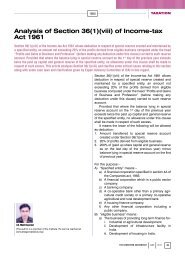The Chartered Accountant
The Chartered Accountant
The Chartered Accountant
Create successful ePaper yourself
Turn your PDF publications into a flip-book with our unique Google optimized e-Paper software.
mittee and, when relevant, the<br />
other members of the audit<br />
committee, will liaise with the<br />
auditor periodically.<br />
• <strong>The</strong> audit committee will meet<br />
the auditor without management<br />
present at least annually.<br />
When All of Those Charged with<br />
Governance are Involved in Managing<br />
the Entity (Ref: Para. 9)<br />
A12. In some cases, all of those<br />
charged with governance are involved<br />
in managing the entity, and the application<br />
of communication requirements<br />
is modified to recognise this<br />
position. In such cases, communication<br />
with person(s) with management<br />
responsibilities may not adequately<br />
inform all of those with whom the<br />
auditor would otherwise communicate<br />
in their governance capacity. For<br />
example, in a company where all directors<br />
are involved in managing the<br />
entity, some of those directors (e.g.,<br />
one responsible for marketing) may<br />
be unaware of significant matters discussed<br />
with another director (e.g., one<br />
responsible for the preparation of the<br />
financial statements).<br />
Matters to be Communicated<br />
<strong>The</strong> Auditor’s Responsibilities in<br />
Relation to the Financial Statement<br />
Audit (Ref: Para. 10)<br />
A13. <strong>The</strong> auditor’s responsibilities in<br />
relation to the financial statement audit<br />
are often included in the engagement<br />
letter or other suitable form of<br />
written agreement that records the<br />
agreed terms of the engagement. Providing<br />
those charged with governance<br />
with a copy of that engagement letter<br />
or other suitable form of written<br />
agreement may be an appropriate way<br />
to communicate with them regarding<br />
such matters as:<br />
• <strong>The</strong> auditor’s responsibility for<br />
performing the audit in accordance<br />
with SAs, which is directed<br />
towards the expression<br />
of an opinion on the financial<br />
statements. <strong>The</strong> matters that<br />
STANDARDS<br />
SAs require to be communicated,<br />
therefore, include significant<br />
matters arising from the audit<br />
of the financial statements that<br />
are relevant to those charged<br />
with governance in overseeing<br />
the financial reporting process.<br />
l <strong>The</strong> fact that SAs do not require<br />
the auditor to design procedures<br />
for the purpose of identifying<br />
supplementary matters to communicate<br />
with those charged<br />
with governance.<br />
l When applicable, the auditor’s<br />
responsibility for communicating<br />
particular matters required<br />
by laws or regulations, by agreement<br />
with the entity or by additional<br />
requirements applicable<br />
to the engagement.<br />
A14. Laws or regulations, an agreement<br />
with the entity or additional<br />
requirements applicable to the engagement<br />
may provide for broader<br />
communication with those charged<br />
with governance. For example, (a) an<br />
agreement with the entity may provide<br />
for particular matters to be communicated<br />
when they arise from services<br />
provided by a firm or network firm<br />
other than the financial statement audit;<br />
or (b) the mandate of a public sector<br />
auditor may provide for matters to<br />
be communicated that come to the<br />
auditor’s attention as a result of other<br />
work, such as performance audits.<br />
Planned Scope and Timing of the<br />
Audit (Ref: Para. 11)<br />
A15. Communication regarding the<br />
planned scope and timing of the audit<br />
may:<br />
(a) Assist those charged with governance<br />
to understand better<br />
the consequences of the auditor’s<br />
work, to discuss issues of<br />
risk and materiality with the auditor,<br />
and to identify any areas<br />
in which they may request the<br />
auditor to undertake additional<br />
procedures; and<br />
(b) Assist the auditor to understand<br />
better the entity and its environment.<br />
A16. Care is required when communicating<br />
with those charged with<br />
governance about the planned scope<br />
and timing of the audit so as not to<br />
compromise the effectiveness of the<br />
audit, particularly where some or all<br />
of those charged with governance are<br />
involved in managing the entity. For<br />
example, communicating the nature<br />
and timing of detailed audit procedures<br />
may reduce the effectiveness of<br />
those procedures by making them too<br />
predictable.<br />
A17. Matters communicated may include:<br />
l How the auditor proposes to<br />
address the significant risks of<br />
material misstatement, whether<br />
due to fraud or error.<br />
l <strong>The</strong> auditor’s approach to internal<br />
control relevant to the<br />
audit.<br />
l <strong>The</strong> application of materiality<br />
in the context of an audit. 10<br />
A18. Other planning matters that it<br />
may be appropriate to discuss with<br />
those charged with governance include:<br />
l Where the entity has an internal<br />
audit function, the extent to<br />
which the auditor will use the<br />
work of internal audit, and how<br />
the external and internal auditors<br />
can best work together in<br />
a constructive and complementary<br />
manner.<br />
l <strong>The</strong> views of those charged<br />
with governance of:<br />
m <strong>The</strong> appropriate person(s)<br />
in the entity’s governance<br />
structure with whom to<br />
communicate.<br />
m <strong>The</strong> allocation of responsibilities<br />
between those<br />
charged with governance<br />
and management.<br />
m <strong>The</strong> entity’s objectives and<br />
10Proposed Revised SA 320, “Materiality in Planning and Performing an Audit”. Hitherto known as AAS 13, “Audit Materiality”. <strong>The</strong> Standard is being revised in the light of<br />
the corresponding Proposed International Standard, ISA 320.<br />
THE CHARTERED ACCOUNTANT 1095 DECEMBER 2008



